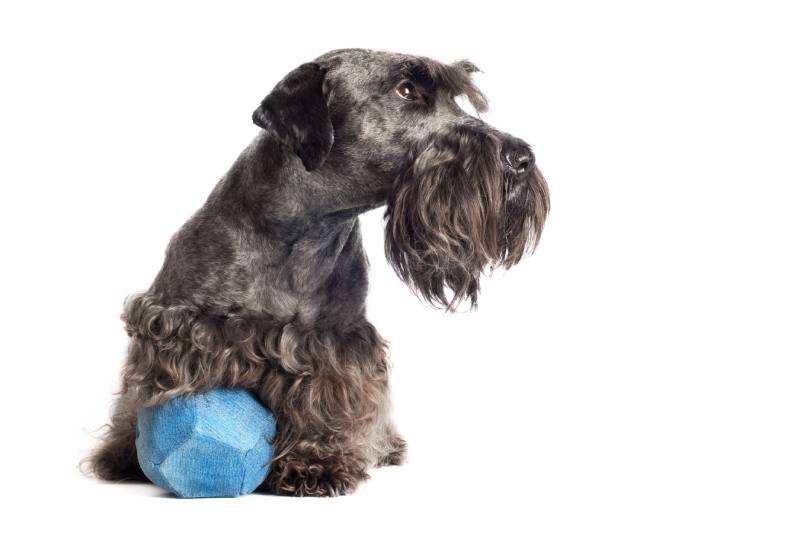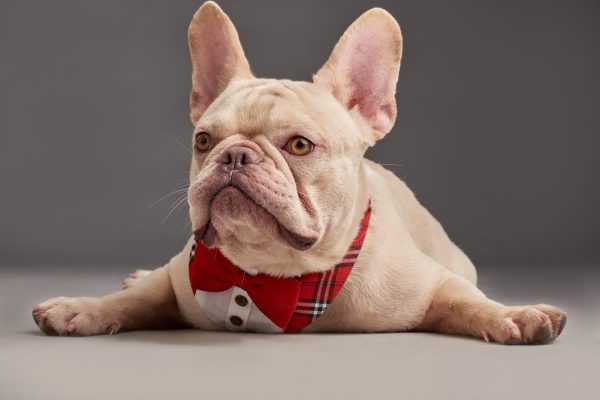In this article
View 8 More +If you’re a fan of terriers but would also like a dog that’s a bit calmer than most terrier breeds tend to be, the Cesky Terrier may be a perfect fit for you. While this dog is a terrier, the breed was bred to be less excitable than other terrier breeds. This makes for an alert and loyal dog who is friendly with their favored people but can be wary of strangers.
How can you determine if the Cesky Terrier is suitable for you and your family? We’ve compiled all the information you need to know about this breed, including health issues the breed is prone to developing, how to groom them, and more. Keep reading!
Breed Overview
Height:
10–13 inches
Weight:
14–24 pounds
Lifespan:
12–15 years
Colors:
Gray, brown
Suitable for:
Those who are home often, families, those living in small spaces
Temperament:
Adventurous, playful, friendly
The Cesky Terrier is a rare breed, so they can be difficult to find, but if you’re lucky to locate one, you’ll find yourself with an incredibly loyal companion. These pups hail from the Czech Republic, are fond of playing, and love to be around their favored people.
Cesky Terrier Characteristics

Cesky Terrier Puppies
Cesky Terriers are quite rare in the U.S., so you’ll most likely have to go through a breeder if you want one of these dogs. This isn’t a breed you’re likely to find in a shelter! Finding a breeder may be a bit of a challenge, as they are few and far between, but when you locate one, ensure they’re reputable before adopting a pup from them. Because of the breed’s rarity, they’ll be on the pricier side.
When you first get your Cesky puppy, they’ll be teeny tiny and absolutely adorable! These pups will be eager to play and will require daily grooming. You’ll also need to begin training them immediately to avoid issues as they get older.
Cesky Terrier Origin & History
The Cesky Terrier comes from the Czech Republic, where the breed was created. In the mid-1900s, Frantisek Horak decided to design a terrier that would not only be a fantastic hunter but also an easygoing companion canine. To do this, he began crossbreeding Scottish Terriers and Sealyham Terriers (there is also speculation that the Wirehaired Dachshund and Dandie Dinmont Terrier were a part of the mix). The Federation Cynologique Internationale (FCI) officially recognized the Cesky in 1963.
This breed didn’t make its way to America until the 1980s. Several more decades passed before these canines were recognized by the American Kennel Club (AKC) in 2011.

Temperament & Intelligence of the Cesky Terrier 🧠
Unlike some terriers and other small dogs, the Cesky is fairly laidback and calm. While they aren’t yappy, they can become nuisance barkers if they don’t have enough to do and get bored. So, you’ll want to ensure they get enough mental and physical stimulation. These pups are wary of strangers and tend to be alert, so they can make excellent watchdogs (plus, their deep bark will quickly let you know someone is at your house).
Despite the occasional barking incidents, these dogs are wonderful for those living in apartments and other small spaces. They can be fairly energetic at times, so playtime and exercise are a must, and the breed loves digging and hunting. They’re fiercely loyal to their people and dislike being on their own. Overall, this is a friendly, fairly chill little dog!

Are These Dogs Good for Families?👪
The Cesky Terrier can make a wonderful pet for the right family. They’re great with kids, and because they’re smaller dogs, you don’t have to worry about them accidentally knocking a child over during play. The breed also isn’t aggressive, so there shouldn’t be any nipping or growling. However, that doesn’t mean you should leave kids and dogs unsupervised during play, as accidents can happen.
Does This Breed Get Along With Other Pets? 🐶 😽
This breed can get along with other canines, though early socialization is key to good interactions between the Cesky and other dogs. When it comes to cats and smaller animals, you might have issues. The Cesky Terrier isn’t aggressive, but they were designed to be hunters, so they have a high prey drive. They may not be able to resist the urge to chase after animals smaller than them. Always supervise interactions between two pets until you know for certain the animals get along.


Things to Know When Owning a Cesky Terrier
You should know plenty more about the Cesky before committing to adopting one. Taking care of any dog involves a lot of responsibility, and you’ll need to learn how to train these pups, what health issues they are prone to developing, and more.
Food & Diet Requirements 🦴
Like all canines, the Cesky Terrier will need high-quality dog food. Because these little dogs are on the muscular side, a food that is higher in protein would be ideal. Talk with your vet about how much to feed your Cesky, though. These pups love to eat, so they will eat everything you put in front of them, which means if you aren’t careful, they could easily become overweight. You’ll want to go easy on the treats because of this tendency, too!

Exercise 🐕
While the Cesky Terrier can be high-energy at times, they aren’t the most active dog breed out there. Exercising them roughly 45 minutes a day should suffice. While this breed is great at things like agility competitions, they’re also perfectly happy going for a long walk (at least, as long as they get to sniff everything you pass!). Games in the backyard or at home will keep them happy and occupied, as well, particularly if these games involve hunting or digging.
One important thing to note about the Cesky is that you do not want to take them off their leash unless they’re in an enclosed area. Because of their high prey drive, they will run after things that catch their attention, like squirrels. Once they’ve gone off like a shot, you may have trouble catching them again.
Training 🎾
The Cesky is intelligent, but the breed is also prone to fits of stubbornness, so training one might occasionally present a challenge. By keeping training sessions on the shorter side and mixing things up so your pup doesn’t get bored, you’ll do much better with teaching the Cesky all they need to know. Remember to keep things positive, too! This breed won’t do well with negative reinforcement, as they are sensitive.
Training of your Cesky should begin as soon as you bring your dog home. Socialization is crucial as this breed tends to be wary of strangers and new things. To get them to be less cautious, you’ll want to start bringing them to new places where they can meet new people and animals sooner rather than later.

Grooming ✂️
Hand stripping isn’t ideal for the Cesky, unlike many terrier breeds, which need their coats hand-stripped. You simply want to clip the body of their coat (fur on the legs and beard area can grow long). A haircut every six weeks should suffice, but unless you’re an old hand at this sort of haircut, you may want to seek a professional groomer’s help. Cesky puppies should be brushed daily, but older Cesky Terriers can be brushed only once or twice a week.
Also, it should be noted that the Cesky tends to have quite a bit of hair growing in the ears, which should be removed during grooming. If it is not, your dog could develop ear infections.
Your Cesky should be bathed regularly, roughly every 4–6 weeks, and their ears should be kept clean of wax and debris. Other than that, you just need to brush your pup’s teeth on a regular basis and keep their nails trimmed.
Health and Conditions 🏥
This dog is a pretty healthy canine. This may be because there are so few breeders of this dog in the U.S., and they are working to remove genetic health issues that tend to arise in the Cesky. A few health conditions may still develop, though.
- Obesity
- Dental disease
- Allergies
- Scotty cramp
- Lens luxation
- Pyometra

Male vs Female
The only real noticeable difference between a female and male Cesky Terrier will be their size, as males will be slightly larger. Females may mature just a touch more quickly, but personality-wise, males and females shouldn’t have any significant differences. However, you might want to consider the cost of spaying versus neutering when making a decision about which sex to adopt, as neutering is far less expensive than spaying.
3 Little-Known Facts About the Cesky Terrier
There’s plenty more to learn about the Cesky Terrier! Below are three facts you might not have known about this dog breed.
1. There are roughly 600 Cesky Terriers in the U.S.
The American Kennel Club considers this dog breed to be one of the six rarest in the world! Currently, they estimate there are only about 600 Cesky Terriers living in the U.S.
2. These dogs love to dig.
If you enjoy a nice-looking yard, then the Cesky Terrier is not the dog for you. These canines are natural-born diggers, and because digging is an instinct for them, it’s not something you can keep them from doing.
3. The Cesky can destroy toys in mere seconds.
You’re going to want to either buy only super durable toys or invest in a lot of toys, in general, to keep the Cesky happy. These pups can be a terror when it comes to their toys and can destroy them in no time.


Conclusion
The Cesky Terrier is an exceptionally rare dog in the United States, but if you do locate one, you’ll have a friendly and loyal companion. These pups can be wary of strangers, which makes them good watchdogs, but can cause issues if they aren’t properly socialized. Though the Cesky doesn’t have a crazy amount of energy, the breed is pretty active, so they’ll enjoy lots of playtime. Watch out for their propensity to dig holes, though!
Featured Image Credit: Dora Zett, Shutterstock


















